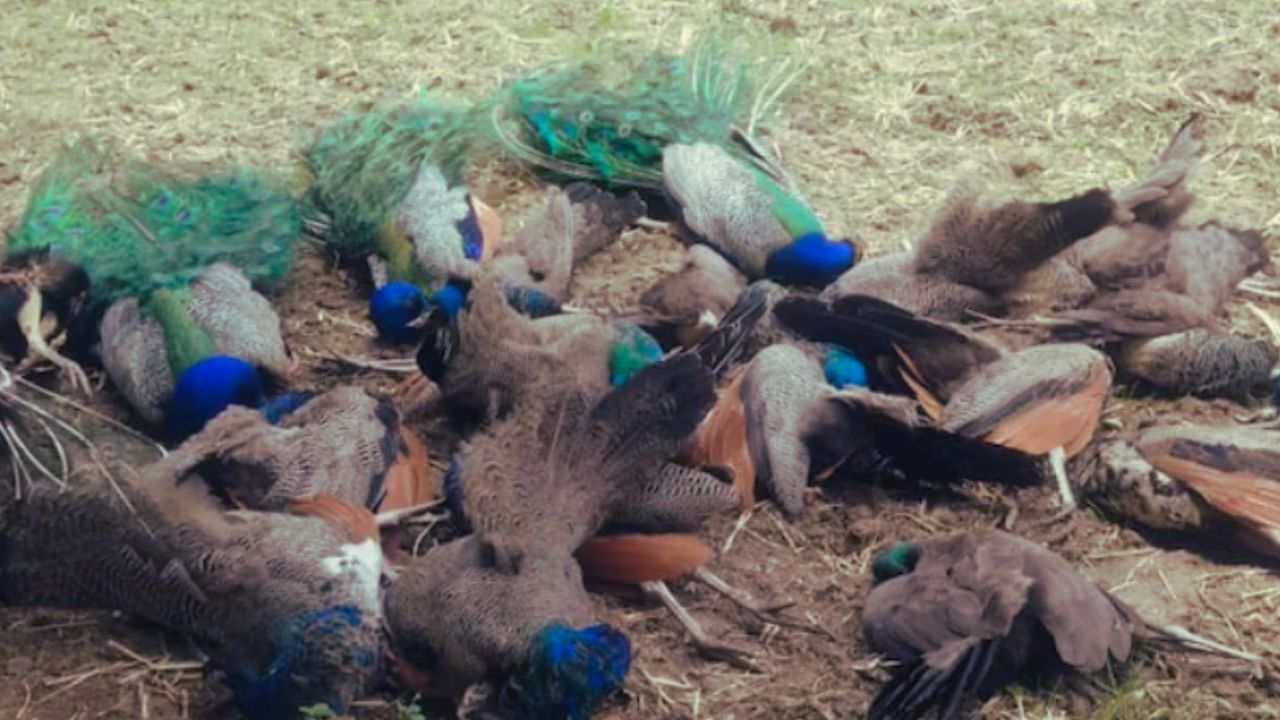
In a troubling development for wildlife conservationists and environmentalists, 20 peacocks were found dead under mysterious circumstances in Karnataka, just weeks after a tigress and her four cubs were reported dead in the same region. The back-to-back wildlife fatalities have triggered alarm bells among forest officials and raised urgent questions about ecosystem health, environmental negligence, and possible poisoning in the area.
Where Did It Happen?
The dead peacocks were discovered in the Koppal district of Karnataka, near the fringes of agricultural land close to forested zones. Locals first noticed the lifeless birds early in the morning and alerted the Forest Department, which swiftly cordoned off the area and initiated an investigation.
The area is known for its biodiversity, hosting various bird and animal species, and acts as a natural corridor for wildlife. The proximity of agricultural activity to forest land, however, has led to growing concerns about pesticide misuse, illegal hunting practices, and habitat degradation.
Tigress and Cubs Death Still Under Investigation
Just weeks before this incident, a tigress and her four cubs were found dead under suspicious circumstances in a nearby wildlife range. Post-mortem reports had hinted at possible poisoning, although forensic confirmation is still pending. The deaths shocked conservation circles and led to calls for stricter protection and better monitoring of forest regions.
Now, with the discovery of 20 dead peacocks — a national bird protected under the Wildlife Protection Act, 1972 — the possibility of systemic threats to regional wildlife can no longer be dismissed.
Possible Causes Being Investigated
Forest officials and veterinarians have begun autopsies and toxicology tests to determine the cause of death. While natural disease outbreaks cannot be ruled out, initial signs suggest poisoning — either accidental or deliberate.
Some of the likely scenarios being probed:
- Pesticide Exposure: Peacocks often forage near farmlands. If grains or water sources were contaminated with high doses of pesticides or insecticides, it could have proven fatal.
- Intentional Poisoning: In some cases, farmers lay out poisoned bait to ward off wild boars or monkeys, which could unintentionally kill other animals, including peacocks.
- Avian Disease: Viral or bacterial infections such as Newcastle Disease or Avian Influenza are being investigated, although no major outbreak has been reported so far.
- Retaliatory Action: The area has seen human-wildlife conflict, particularly with predators. It is also being examined whether the poisoning of the tigress and now peacocks could be a revenge tactic by locals against perceived animal threats.
Environmental and Legal Implications
The peacock is India’s national bird, and its killing — intentional or otherwise — is a punishable offence under the Wildlife Protection Act. A team from the State Forest Department, wildlife veterinarians, and toxicology experts is now working in coordination to ensure a thorough probe.
This incident, coupled with the recent tigress and cub deaths, indicates deeper, systemic flaws in wildlife protection, local awareness, and regulatory enforcement.
Environmental groups are demanding:
- A high-level investigation into both cases
- Stricter pesticide regulation near wildlife zones
- Enhanced awareness programs for farmers
- Installation of camera traps and increased patrolling
- A rapid response team for wildlife emergencies
Public and Political Reactions
The news of the mass deaths has sparked outrage on social media, with wildlife enthusiasts and animal rights groups calling for accountability. Several political leaders have also weighed in, urging the Karnataka government to tighten wildlife safety protocols and strengthen habitat protection policies.
Local communities, meanwhile, are growing anxious, both due to the sudden deaths and the scrutiny that now surrounds their traditional farming practices.

What This Means for Karnataka’s Wildlife
Karnataka has long been one of India’s biodiversity-rich states, home to species like the tiger, elephant, leopard, and numerous birds, including the majestic peacock. However, human encroachment, expanding agriculture, and inadequate buffer zones between forests and farmlands are putting tremendous pressure on its ecosystems.
The repeated loss of both apex predators like the tigress and indicator species like the peacock within such a short span highlights a disturbing trend of ecosystem instability.
A Call to Action
The death of 20 peacocks — on the heels of a tragic tigress and cubs’ demise — is more than a wildlife tragedy. It is a wake-up call for environmental agencies, local governments, and communities to recognize the cracks in our conservation framework.
As authorities race to find answers, this series of incidents should serve as a turning point — pushing for urgent reforms, increased vigilance, and above all, a renewed commitment to protecting India’s vanishing wildlife.
If the silence of these beautiful birds doesn’t speak volumes, what will?



